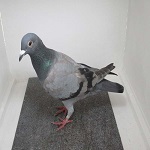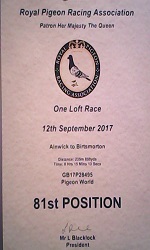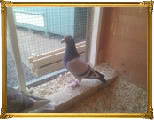| Countrywide Corns |  |
| Forum Syndicate 2019 | Pigeon World Forum Syndicate Bird takes 44th Place, in the 2019 RPRA One Loft Final.The Bird is Frans Zwol Bloodline, Bred and supplied by Darren Palmer (Oldstrain)  |
| Forum Syndicate 2019 | Pigeon World Forum Syndicate also takes 100th Place, in the 2019 RPRA One Loft Final. The Bird is Frans Zwol Bloodline, Bred and supplied by Darren Palmer (Oldstrain)

|
| Who is online? | In total there are 17 users online :: 0 Registered, 0 Hidden and 17 Guests :: 1 Bot None Most users ever online was 833 on Wed Nov 10, 2021 12:30 pm |
| Forum Syndicate 2017 | Pigeon World Syndicate Bird takes 81st Place in the 2017 Final Race, The Bird is Dia Evans Bloodlines and was Bred and supplied by Tumley Lofts Stud.  |
| R.P.R.A Certificate. | Pigeon World Forum Syndicate take 81st Place in the 2017 R.P.R.A. Final, with a Pigeon Bred and Supplied by Tumley Lofts Stud. |
| Top posting users this week | |
| Statistics | We have 1297 registered users
The newest registered user is tharunjohar50
Our users have posted a total of 222847 messages in 14006 subjects
|
| Oldstrain/Darren`s Winner of winners. 2012. |  |
| From Fed Topper to Master Chef |  The N.E.H.U race from Melton Mowbray 21/4/2012 was won by Peel bros of South Shields, they took 1st club 1st fed, also taking 2nd and 4th club and 15 of the 25 birds clocked in the club......well done Peel brothers. The N.E.H.U race from Melton Mowbray 21/4/2012 was won by Peel bros of South Shields, they took 1st club 1st fed, also taking 2nd and 4th club and 15 of the 25 birds clocked in the club......well done Peel brothers. |
| | | A long read, but |  |
| | | Author | Message |
|---|
Daz
Youngbird

Posts : 4072
Join date : 2018-07-15
Age : 76
Location : Northants
 |  Subject: A long read, but Subject: A long read, but  Sat Jan 18, 2020 12:35 pm Sat Jan 18, 2020 12:35 pm | |
| Well worth it.
Rotavirus as the causative agent of YBS
by Karl » Sun Jan 12, 2020 12:05 pm
Breakthrough in the medical guidance of racing birds
Author:
10/01/2020 - Ruben Lanckriet
Veterinary surgeon Ruben Lanckriet wrote an in-dept and well-grounded report on a medical breakthrough regarding the rotavirus, and the vaccine that was recently registered.
The Rotavirus and its role as primary cause for young pigeon disease
For years, pigeon fanciers have seen such symptoms as vomiting, diarrhoea and deaths among their young birds. A watchful fancier could often spot these issues in advance, when the young birds suddenly struggle to arrive home after a training flight, or when one or more pigeons would hesitantly walk to the feeding tray, if at all. Crop retention is often seen among these pigeons as well, also referred to as water in the crop. This means the gastrointestinal function is affected. This in turn can lead to vomiting, and the pigeons' droppings can become affected as well, and can sometimes turn green, as a result of the pigeons no longer eating. Oftentimes, you can spot yellow pigments in their urine as well, which indicates a major liver problem. An autopsy will often reveal major liver damage. By taking quick action, using antibiotics, anti-parasitic drugs, usually against trichomoniasis or hexamita, and liver supporting supplements, you can limit the impact of the disease or eradicate the disease from your young birds' loft entirely. This suggests that the young pigeon disease is often linked to a bacterial and/or parasitic component, although this syndrome had never been fully understood.
Based on earlier research and autopsies from the 1990s, the adenovirus was considered to be the main cause. However, more recent autopsies on pigeons that died from the young bird disease have shown that the virus has been found only sporadically. In addition, researchers failed to trigger the same symptoms in pigeons that were deliberately infected with the adenovirus or other potential pathogens. For years, international academics suggested that the adenovirus could not be the primary cause, or that it was no longer the primary cause, if you assume that it had been in the past (the so-called adenovirus types I and II). That is why in recent decades the disease is increasingly referred to as "young pigeon disease syndrome" or YPDS. And yet, the disease is still colloquially referred to as "adeno", because it used to be described as the adeno-coli syndrome in the past.
The adenovirus is sometimes found (but rather sporadically) when performing an autopsy on such pigeons, although in many cases the herpes or circo-virus is much more prevalent. Some pigeons had the paramyxovirus in their system, while bacteria like E. coli (which explains the need for antibiotics) and such parasites like trichomonas are sometimes discovered as well, just like hexami (although not as frequent). However, none of these pathogens were found every single time. In fact, it occurred regularly that none of these pathogens were spotted at all. Besides, the E. Coli bacterium is known to live in the (large) intestine. When E. Coli is found in the large intestine during an autopsy, this basically means nothing. When the bacterium was found in a spot other than the large intestines however, researches surprisingly discovered that the bacterial strains that were found among pigeons with the worst symptoms had few or no pathogenic features when they typified the bacteria's DNA, even though these strains were found in the duodenum (the first part of the small intestine), which is not where they are commonly found.
According to academics, these findings seem to confirm that the primary cause for this disease was still to be discovered, and that the different pathogens are no more than secondary pathogens that take advantage of the pigeon's health situation to further aggravate or complicate the disease. That is why a number of reputable researchers and veterinary surgeons, led by Dr. Elisabeth Peus (Germany) started to investigate different causes for the disease.
In the meantime, a new disease broke out in Australia in 2016, which led to many deaths among both old and young birds. The symptoms of this disease had a remarkable resemblance to what we have seen in Europe for years, the difference being that it affected many old birds as well, which has not been the case in Europe (except in the 1990s, when the disease first appeared). After a lot of diagnostic research and the exclusion of adeno, PMV, herpes etc., and thanks to the efforts of veterinary surgeon Colin Walker and others, it was eventually discovered that this 'new' disease was caused by the not previously defined Rotavirus type A. Since this diagnose was established in Victoria, it was referred to as the Victorian pigeon virus. Following the warnings from Australia, the FCI decided to ban all Australian pigeons from their FCI one loft races, which the Million Dollar Race in South Africa had already decided to do in 2017. In part thanks to these discoveries, European researchers such as Dr. Rubbenstroth (from the Friedrich Loeffler Institute, a former project manager at the Freiburg University) began screening for variants of the Rotavirus. The results soon revealed that the rotaviruses - which is similar to the Victoria Virus - were found in all the diagnostic materials from young birds that had carried the symptoms described earlier. Moreover, these variants were more commonly found in pigeons with the worst symptoms.
The variants of these viruses were to some extent similar to the Victoriavirus, although they were not identical. And research that was conducted on older diagnostic materials from years ago led to the same conclusion. There was a higher occurrence of these Rotavirus variants in almost all of the diagnostic samples of the typical young pigeon disease YPDS that had been stored, including the oldest samples from the year 2000. Interestingly enough, researchers also discovered newer variants of this virus every several years, and these appeared to affect more pigeons. Additionally, they were able to experimentally reproduce the symptoms by infecting young birds with this newly found virus, which clearly proves that the primary cause had finally been discovered! In hindsight, it does seem like the rumours of a 'new' disease emerging, as was suggested by different media and fanciers, were simply not true. Researchers believe that this virus has always been the primary cause for the young pigeon disease, and I share this opinion. The truth is that the disease had not yet been adequately investigated. That does not mean that the other pathogens involved should be neglected or ignored of course.
As such, it is conceivable that the Australian virus does have European origins. But how can you explain the phenomenon of Australian old birds getting sick and dying? Well, this is likely to be one of many instances of a pathogen not initially spread among Australia's animal population. As a result, this new pathogen could easily affect these highly susceptible pigeons, including the old birds. In Europe, these viruses have been found across the entire population, and so the old birds have already developed immunity, which keeps them from contracting the disease. However, it is likely that European old birds still get infected with this virus regularly as well, albeit at a subclinical level, without clear symptoms. This infection will then act like a type of booster vaccine.
For years, rotaviruses have been known to cause severe gastrointestinal problems among humans and animals. Looking back, it seems to make sense that this type of virus can lead to similar symptoms and illnesses among pigeons and birds. From late 2017 onwards a more severe variant of the Rotavirus has been wreaking havic in our regions, causing many deaths among young birds, with a peak from March to June 2018, as well as in the spring of 2019. Each time the typical symptoms occurred (crop stasis, vomiting, severe liver damage in young birds), the Rotavirus was found in the liver during the autopsy. It was only in 2019 that diagnostic labs, under the impulse of a number of vets, have started to provide routine tests to test for the Rotavirus in the pigeons' organs or droppings.
A major benefit and one of the most crucial conclusions of these studies for pigeon fanciers, is that pigeons can be easily vaccinated against the Rotavirus relatively. The production of Rotavirus vaccines began in 2018 and mostly last year, comprising both auto vaccines (vaccines suited only for pigeon families) and commercially available vaccines. To me, as a veterinary surgeon, the effectiveness of these vaccinations is the greatest evidence of this breakthrough in the medical guidance of racing birds: pigeons are clearly well protected against this disease once we administer this vaccine, and it reduces the number of deaths to near zero. It is my impression that it takes around 14 days for the vaccine to provide optimal protection, which means the disease can still strike until two weeks after vaccination. Logically speaking, the longer the pigeons are vaccinated, the greater the chance of them not dying, which we have seen in practice.
There appears to be a difference in the severity of the disease if the pigeons get sick two days after the vaccination as compared to ten days. In addition, some fellow veterinary surgeons have indicated that they have successfully administered an emergency vaccination: vaccinating a diseased pigeon to gain control over the disease more quickly. Although I think prevention is always the better option. In any case, it is strongly recommended to preventatively vaccinate your young birds in time, especially if you have had many diseased or dead pigeons in previous years. It goes without saying that we still have limited knowledge on which of the vaccination schemes would offer the best protection. We will likely have to take into account maternal immunity (when the mother's antibodies are transferred to the egg), and the fact that vaccines have to be administered in time to be ahead of a possible infection. At the age of four weeks, pigeons are probably still too young for an effective vaccination, because of the maternal immunity still playing a role. Perhaps this could be bypassed with two or three different vaccinations with an interval of a few weeks. The best age could well be 6 to 8 weeks old. Needless to say, research is still ongoing. You can always consult your vet for further advice.
We would like to extensively thank the many colleagues and researchers involved, for their scientific efforts and for what has clearly been a major breakthrough in the medical guidance of our beloved racing birds.
Sources:
Identification of a novel clade of group A rotaviruses in fatally diseased domestic pigeons in Europe. Rubbenstroth et al (Transbound Emerg Dis. 2019)
A novel group A rotavirus associated with acute illness and hepatic necrosis in pigeons (Columba livia), in Australia. McCowan et al (PLoS One. 2018)
|
|   | | halcanada80
Hatchling

Posts : 208
Join date : 2020-01-10
 |  Subject: Re: A long read, but Subject: Re: A long read, but  Sat Jan 18, 2020 3:02 pm Sat Jan 18, 2020 3:02 pm | |
| |
|   | | Knackered
Oldbird


Posts : 14506
Join date : 2013-03-11
 |  Subject: Re: A long read, but Subject: Re: A long read, but  Sun Jan 19, 2020 1:31 am Sun Jan 19, 2020 1:31 am | |
| |
|   | | Daz
Youngbird

Posts : 4072
Join date : 2018-07-15
Age : 76
Location : Northants
 |  Subject: Re: A long read, but Subject: Re: A long read, but  Sun Jan 19, 2020 10:20 am Sun Jan 19, 2020 10:20 am | |
| Sorry, I forgot to give mention the sauce I obtained it. A sad lacking on my behalf. It was from the Alberta Classic post of Karl's. |
|   | | MISTY
Oldbird

Posts : 9024
Join date : 2018-01-28
Age : 89
Location : SCARBOROUGH
 |  Subject: Re: A long read, but Subject: Re: A long read, but  Sun Jan 19, 2020 10:21 am Sun Jan 19, 2020 10:21 am | |
| There was a time, a FAR BETTER TIME, in our sport when very little disease and very few problems were encountered.
Then the whole attitude to our sport began to change.
Large amounts paid for pigeons to put to stock and sell offspring, not risking losing the investment to disease they were treated irrespective of any illness present, so no one knew the natural healthy from those that should have been culled.
The first offspring were retained to stock, some for several generations. so no one has a clue which were good bad or indifferent, health wise regarding the immune system.
This has gone on for over 50 years, so you do not have to be very bright to understand the significance of.
Then along came the vets, commercial boys etc; the experts resulting in the present day pigeons being nothing like those, health wise of 70 years ago.
If the sport got rid of all the experts and commercial boys within maybe 200 years the damage done could be undone.
Roll on.
Regards.
|
|   | | Daz
Youngbird

Posts : 4072
Join date : 2018-07-15
Age : 76
Location : Northants
 |  Subject: Re: A long read, but Subject: Re: A long read, but  Sun Jan 19, 2020 3:03 pm Sun Jan 19, 2020 3:03 pm | |
| Interestingly this I find quote' … According to academics, these findings seem to confirm that the primary cause for this disease was still to be discovered, and that the different pathogens are no more than secondary pathogens that take advantage of the pigeon's health situation to further aggravate or complicate the disease. That is why a number of reputable researchers and veterinary surgeons, led by Dr. Elisabeth Peus (Germany) started to investigate different causes for the disease'.
Seems maybe the immunity has been blown and hence a secondary pathogens gets in and hence more to be sorted. I also - and often ask - does y/b's stay dormant and then passed on!
Without a doubt many lofts have birds boosted by drugs, aids etc. etc that make a pigeon look the part, but it's constitution is blown and has not the means to fight back, |
|   | | Sponsored content
 |  Subject: Re: A long read, but Subject: Re: A long read, but  | |
| |
|   | | | | A long read, but |  |
|
Similar topics |  |
|
| | Permissions in this forum: | You cannot reply to topics in this forum
| |
| |
| |
